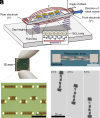Electrokinetic propulsion for electronically integrated microscopic robots
- PMID: 40663604
- PMCID: PMC12305017
- DOI: 10.1073/pnas.2500526122
Electrokinetic propulsion for electronically integrated microscopic robots
Abstract
Semiconductor microelectronics are emerging as a powerful tool for building smart, autonomous sub-millimeter robots. Yet a number of existing microrobot platforms, despite significant advantages in speed, robustness, power consumption, or ease of fabrication, have no clear path toward electronics integration, limiting their potential for intelligence. Here, we show how to upgrade a class of self-propelled particles into electronically integrated microrobots, reaping the best of both platforms in a single design. Inspired by electrokinetic micromotors, these robots generate electric fields in a surrounding fluid, and by extension propulsive electrokinetic flows. The underlying physics is captured by a model in which robot speed is proportional to applied current, making design and control straightforward. As proof, we build basic robots at the 100-micron scale that use rudimentary, on-board photovoltaic circuits and a closed-loop optical control scheme to navigate waypoints and move in coordinated swarms at speeds of up to one body length per second. Broadly, the unification of micromotor propulsion with on-robot electronics invites future work to realize robust, fast, easy to manufacture, electronically programmable microrobots that remain operationally viable for months to years.
Keywords: electrokinetic propulsion; micromotors; microrobots.
Conflict of interest statement
Competing interests statement:The authors declare no competing interest.
Figures




References
-
- X. Wu et al. , “A 0.04MM316NW wireless and batteryless sensor system with integrated cortex-M0+ processor and optical communication for cellular temperature measurement” in 2018 IEEE Symposium on VLSI Circuits, K. Chang, K. Takeuchi, Eds. (IEEE, 2018), pp. 191–192.
-
- K. Blutman et al. , A low-power microcontroller in a 40-nm CMOS using charge recycling. IEEE J. Solid State Circuits 52, 950–960 (2017).
-
- A. T. Do, S. M. A. Zeinolabedin, D. Jeon, D. Sylvester, T. T. H. Kim, An area-efficient 128-channel spike sorting processor for real-time neural recording with 0.175 μW/channel in 65-nm CMOS. IEEE Trans. Very Large Scale Integr. Syst. 27, 126–137 (2019).
-
- G. Atzeni et al. , “A 260×274 um2 572 nW neural recording micromote using near-infrared power transfer and an RF data uplink” in 2022 IEEE Symposium on VLSI Technology and Circuits (VLSI Technology and Circuits), G. Jurczak, B. Nikolić, Eds. (IEEE, 2022), pp. 64–65.
Grants and funding
LinkOut - more resources
Full Text Sources
Research Materials

